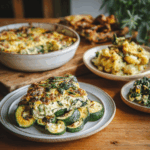Follow Me On Social Media!
Dairy Free Ricotta Cheese That Tastes Like the Real Thing
Looking for the perfect dairy free ricotta cheese that actually delivers on flavor and texture? You’re not alone. With the rise of lactose intolerance, plant-based diets, and clean eating, more people than ever are searching for satisfying alternatives. This article will guide you through how to make a delicious dairy free ricotta cheese at home, the best substitutes you can find in stores, and how to use it in your favorite recipes. Whether you’re cooking for dietary needs or simply curious, this guide is your ultimate starting point for all things dairy free and creamy.
The Story & Intro
The Heart Behind My Dairy Free Ricotta Cheese Journey
A Family Recipe Reimagined, Without the Dairy
The first time I made dairy free ricotta cheese, I was determined to recreate the creamy, slightly tangy texture I remembered from my grandmother’s baked ziti. I stood in my warm Savannah kitchen, apron on, ingredients lined up like soldiers ready for duty. A few years ago, I found out I was lactose intolerant. Let me tell you—giving up ricotta felt like a betrayal to my Italian roots. But instead of letting that limit my comfort food cravings, I went back to basics. I drew on everything I’d learned as a chef, and my earliest memories with my grandma, to build something new from the old.
I tested cashews, tofu, almonds—even a blend of sunflower seeds and oats once. What surprised me most? You don’t need dairy to achieve richness or flavor. You just need a balance of acid, fat, and salt. A good dairy free ricotta cheese should be creamy, spreadable, and subtle enough to blend into both sweet and savory dishes.
From plant-based lasagna to dollops on warm toast with roasted tomatoes, this dairy free version changed the way I cook—more compassionate, more creative, and just as comforting. If you’re exploring dairy free options or have dietary restrictions, I’ve got you covered.
While crafting this recipe, I also tested it in desserts like pumpkin cheesecake cookies and savory dishes like garlic parmesan chicken pasta (yes, even without real cheese). Turns out, the possibilities are deliciously endless.
Why Dairy Free Ricotta Cheese Is Taking Over Fridges
Dairy free ricotta cheese isn’t just for vegans anymore. It’s quickly becoming a staple in kitchens of those with lactose intolerance, food allergies, or just a curiosity for trying new, plant-forward meals. Unlike store-bought vegan cheeses of the past, today’s versions—especially the homemade kind—are creamy, flavorful, and versatile.
When you make it yourself, you control the ingredients. That means fewer preservatives and more whole foods like soaked cashews, firm tofu, or almonds. The flavor comes alive with simple additions like lemon juice, apple cider vinegar, garlic, or nutritional yeast. Texture-wise, you can get a fluffy, whipped consistency or go for a denser, spoonable spread.
The best part? It works beautifully in recipes. From layering in lasagna to filling gluten-free lemon muffins with a creamy surprise, there’s no shortage of ways to put this to use.
Next, we’ll break down the best ingredients and tools for your dairy free ricotta, plus what makes each variation shine depending on your cooking needs. Stay tuned for Part 2.
How to Make Dairy Free Ricotta Cheese at Home
The Ingredients That Make It Work

Cashew, Tofu, Almond? Choose Your Base Wisely
The heart of dairy free ricotta cheese is its creamy base—and each one brings something unique to the table. Cashews are my go-to for their smooth, neutral flavor. Tofu adds protein and that light, airy texture we love in traditional ricotta. Almonds bring a hint of nuttiness and work beautifully when soaked and peeled.
Let’s compare your top options:
| Base Ingredient | Texture Result | Flavor Profile |
|---|---|---|
| Raw Cashews (soaked) | Creamy, thick, spreadable | Neutral, buttery |
| Firm Tofu | Light, fluffy | Very mild, absorbs seasoning |
| Blanched Almonds | Grainier, similar to cottage cheese | Mildly nutty |
Don’t forget to add key flavor enhancers: lemon juice or apple cider vinegar for acidity, nutritional yeast for umami, garlic for bite, and a little olive oil for richness.
Need a little spice? A dash of chili garlic sauce swirled in makes a fabulous savory dip.
Step-by-Step: How to Make Creamy Dairy Free Ricotta
Making dairy free ricotta is as easy as blend, taste, and adjust. Here’s the quick process:
- Soak your cashews or almonds for 2–4 hours (skip this if using tofu).
- Drain and rinse.
- In a food processor, combine:
- 1 cup soaked base (cashews, almonds, or tofu)
- 1–2 tablespoons lemon juice
- 1 tablespoon olive oil
- 1 tablespoon nutritional yeast
- ½ teaspoon garlic powder
- ¼ teaspoon salt
- 2–4 tablespoons water (to adjust texture)
- Blend until smooth but slightly textured.
- Taste and adjust. Add more salt, lemon, or garlic as needed.
That’s it! You’ll have a creamy spread that works just as well in savory dishes like baked shells or sweet ones like strawberry cookies.

Coming up in Part 3: we’ll talk about how to use this dairy free ricotta in your everyday meals and showcase some surprising combinations that work beautifully.
Ways to Use Dairy Free Ricotta Cheese
Everyday Meals Made Better with Dairy Free Ricotta
From Breakfast Toasts to Weeknight Lasagna
Dairy free ricotta cheese isn’t just a substitute—it’s a fresh way to enjoy creamy textures and rich flavors, no dairy needed. One of my favorite ways to start the day is with a thick slice of sourdough topped with a spread of dairy free ricotta, sliced tomatoes, cracked pepper, and fresh basil. It’s satisfying, clean, and packed with flavor.
For dinner? Stir it into pasta, layer it into lasagna, or dollop it onto veggie pizza. It melts into warm dishes just enough to add richness without overpowering. I especially love using it in stuffed shells with spinach or in a dairy-free white pizza using garlic oil and caramelized onions.
Try adding a scoop to your next sweet potato muffin recipe or folding it into warm cooked grains for a protein-rich side dish. This creamy spread transforms whatever it touches—without the bloat, heaviness, or allergens of traditional ricotta.
Sweet Surprises: Dessert-Ready and Creamy Smooth
You might be surprised to learn that dairy free ricotta also works in desserts. A slightly sweetened version pairs beautifully with berries, maple syrup, or cocoa. Add a touch of vanilla, a spoonful of agave, and it becomes a luscious base for fruit tarts or parfaits.
One quick win? Blend it with lemon zest and honey, then spoon it over healthy lemon muffins or swirl it into pancake batter. It’s a subtle richness that elevates the entire dish. You can even turn it into a no-bake cheesecake filling.
Still got some leftover ricotta? Mix it with cocoa powder and a splash of espresso and use it as a dip for strawberries or cookies. Or spread it on toast with sliced banana and cinnamon for a quick morning pick-me-up.
Whether you’re craving savory or sweet, dairy free ricotta is endlessly adaptable—and your body will thank you for the upgrade.
Next up: Part 4 will walk you through buying options, storage tips, and how to know when your dairy free ricotta is at its prime.
Buying Tips, Storage, and Shelf Life
Where to Buy Dairy Free Ricotta Cheese—and What to Look For
Shopping Smart: Best Brands & Ingredients to Watch For
Not everyone has time to whip up a fresh batch of dairy free ricotta cheese at home. Luckily, you’ll find plenty of high-quality options in stores now, especially at health markets like Whole Foods, Sprouts, or online shops. Look for brands that use minimal, whole ingredients—preferably cashew- or almond-based.
When choosing a product, skip anything with added sugars, gums, or unrecognizable fillers. A great dairy free ricotta should have a creamy texture, light tang, and just enough salt. My go-to commercial options are those that mimic that soft, slightly grainy mouthfeel traditional ricotta is known for—perfect in everything from lasagna to black bean brownie batter.
And don’t forget to check for soy if you’re avoiding it. Many tofu-based options are great, but almond and cashew versions often have a more delicate flavor that pairs better with both sweet and savory dishes.
Storage Tips: Keep It Fresh & Flavorful
Homemade dairy free ricotta can last 4–5 days in an airtight container in the fridge. Be sure to store it away from strong-smelling ingredients like onions or garlic to avoid unwanted flavor absorption.
Here’s a quick guide:
| Type | Storage Time | Notes |
|---|---|---|
| Homemade (Cashew/Tofu) | 4–5 days | Use airtight container; refrigerate immediately |
| Store-Bought (Opened) | Up to 7 days | Follow label instructions; check texture/smell before use |
| Frozen (Homemade Only) | Up to 2 months | Thaw overnight; re-blend if texture separates |
Freezing tip: Freeze in small portions using silicone molds or freezer-safe jars. Once thawed, give it a quick stir or pulse in the blender to revive that creamy texture.
Pair your frozen batch with something sweet like gluten-free lemon muffins or stir into grain bowls for a fast plant-based protein boost.
Frequently Asked Questions
Can you get dairy free ricotta cheese?
Yes! You can buy it at many grocery stores or make it at home using cashews, tofu, or almonds. It’s widely available under vegan or lactose-free labels.
What is a vegan substitute for ricotta cheese?
Tofu, cashews, or almonds blended with lemon juice, garlic, and olive oil make excellent vegan substitutes. Store-bought brands like Kite Hill or Tofutti also work well.
Can you buy lactose free ricotta?
Some brands offer lactose-free ricotta made with enzyme-treated milk. However, plant-based versions are fully dairy-free and naturally lactose-free.
What is the best substitute for ricotta cheese?
The best depends on your needs: tofu for a lighter, fluffier texture; cashews for richness; or blanched almonds for a more traditional mouthfeel.
Conclusion
Dairy free ricotta cheese isn’t just a substitute—it’s a fresh, flavorful staple worth adding to your kitchen rotation. Whether you’re lactose intolerant, vegan, or just curious, it offers a healthy, satisfying way to enjoy creamy textures without compromise. From savory dishes to sweets, the possibilities are endless—and delicious.
Let’s keep your meals simple, seasoned, and full of joy.





